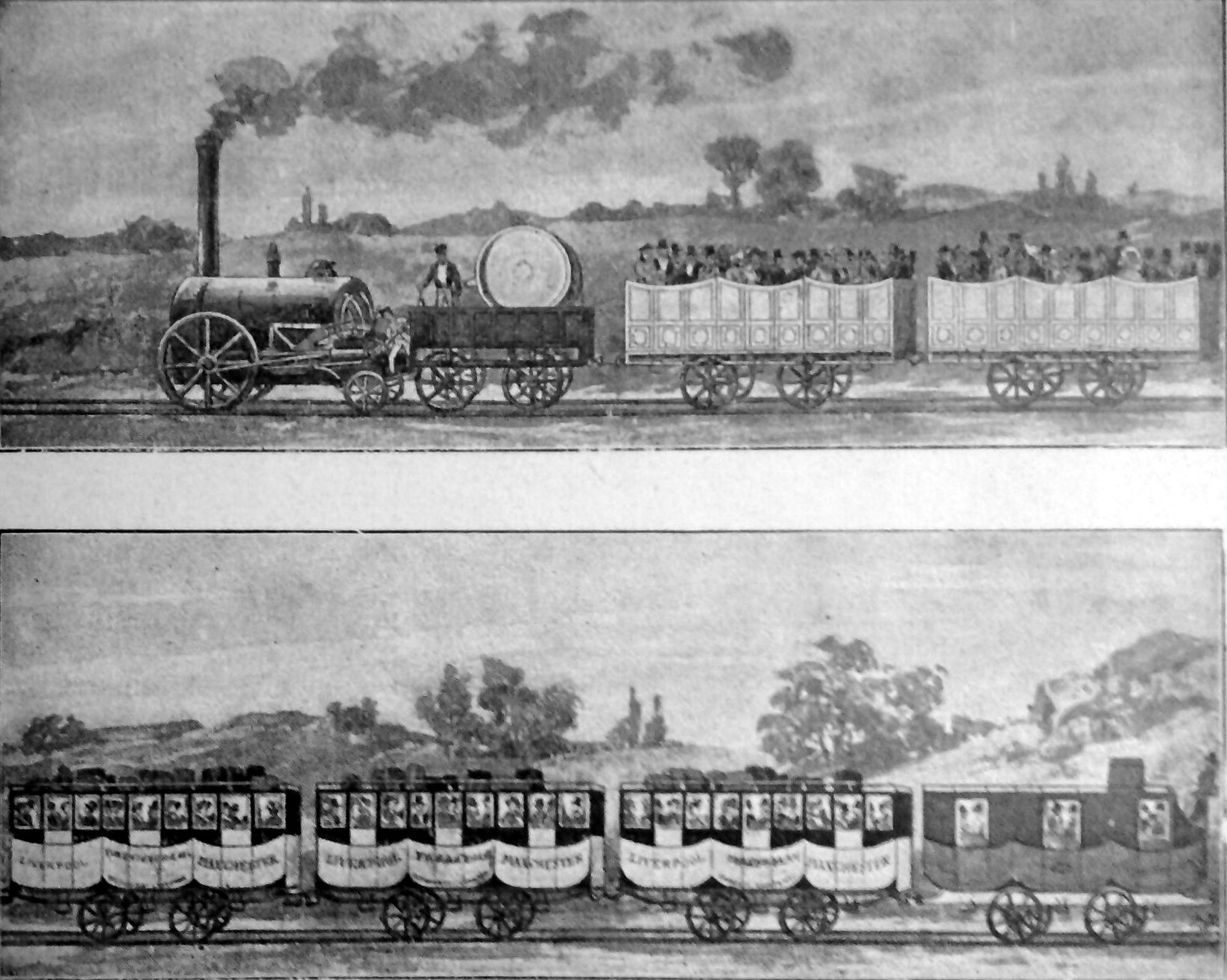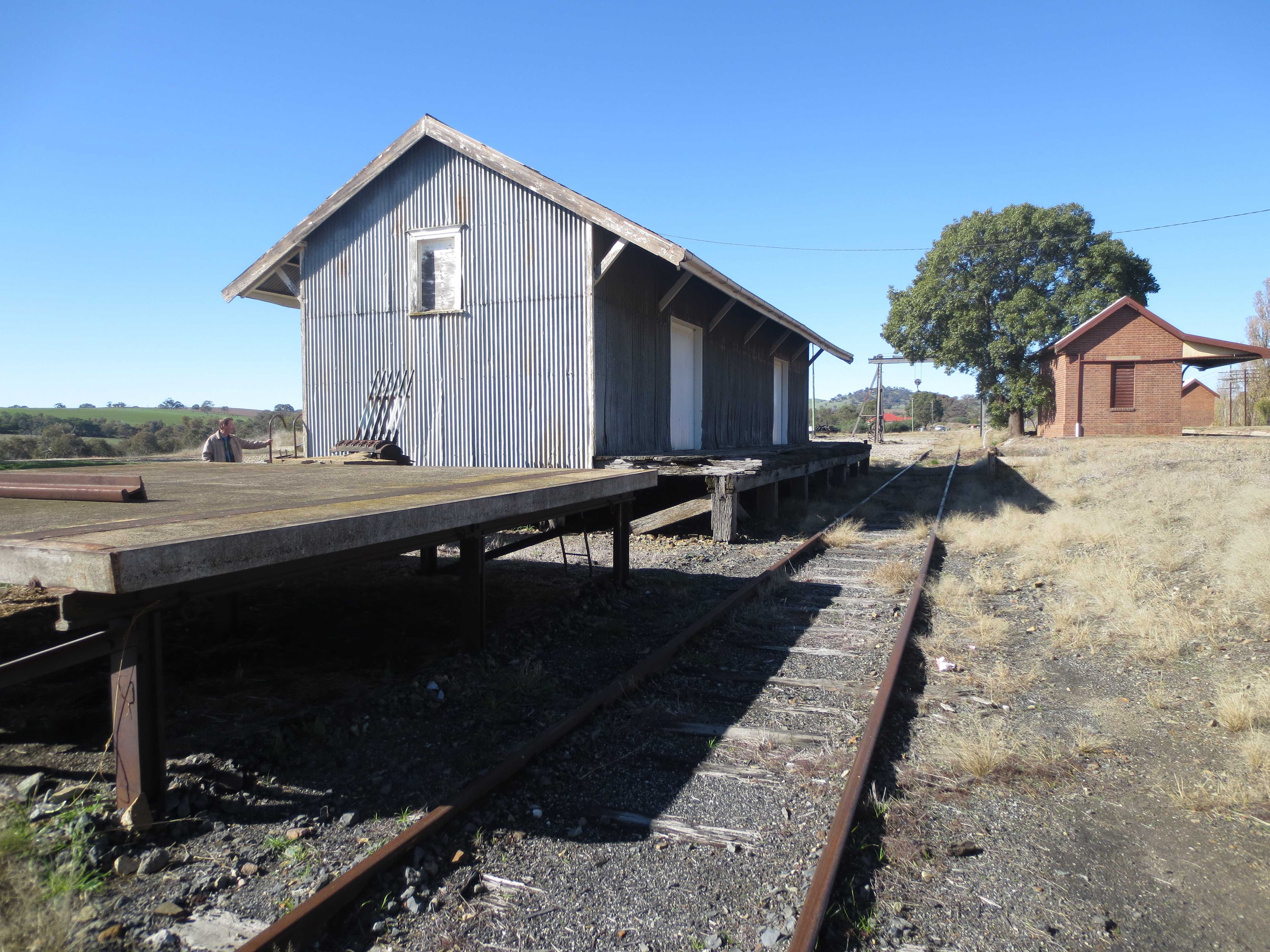|
Crown Street Railway Station
Crown Street Station was a passenger railway terminal station on Crown Street, Liverpool, England. The station was the world's first intercity passenger station, opening in 1830, also being the railway terminal station for Liverpool. Used for passengers for only six years, the station was demolished as the site was converted into a goods yard. The goods yard remained in use until 1972. The location of the station is now a park with little trace of the station or goods yard. History The station opened on 15 September 1830 as the Liverpool passenger terminus of the Liverpool and Manchester Railway, the world's first public passenger line. This gave the station the distinction of being the world's first dedicated intercity passenger railway station as the first train ran from Liverpool. Manchester's corresponding Liverpool Road terminus station opened on the same day, being the destination of the first train from Liverpool. The architecture is attributed to George Stephenson. Th ... [...More Info...] [...Related Items...] OR: [Wikipedia] [Google] [Baidu] |
Liverpool And Manchester Railway
The Liverpool and Manchester Railway (L&MR) was the first inter-city railway in the world. It opened on 15 September 1830 between the Lancashire towns of Liverpool and Manchester in England. It was also the first railway to rely exclusively on locomotives driven by steam power, with no horse-drawn traffic permitted at any time; the first to be entirely double track throughout its length; the first to have a true signalling system; the first to be fully timetabled; and the first to carry mail. Trains were hauled by company steam locomotives between the two towns, though private wagons and carriages were allowed. Cable haulage of freight trains was down the steeply-graded Wapping Tunnel to Liverpool Docks from Edge Hill junction. The railway was primarily built to provide faster transport of raw materials, finished goods and passengers between the Port of Liverpool and the cotton mills and factories of Manchester and surrounding towns. Designed and built by George Ste ... [...More Info...] [...Related Items...] OR: [Wikipedia] [Google] [Baidu] |
Liverpool Lime Street Railway Station
Liverpool Lime Street is a terminus railway station and the main station serving the city centre of Liverpool. Opened in August 1836, it is the oldest still-operating grand terminus mainline station in the world. A branch of the West Coast Main Line from London Euston terminates at the station, as does the original Liverpool and Manchester Railway. Journeys from Lime Street cover a wide range of destinations across England, Scotland and Wales. Having realised that their existing Crown Street railway station was too far away from the city centre, the Liverpool and Manchester Railway commenced construction of the more central Lime Street station in October 1833. Designed by John Cunningham, Arthur Holme and John Foster Jr, it was officially opened in August 1836. Proving to be very popular with train commuters, expansion of the station had become necessary within six years of its opening. The first expansion, which was collaboratively produced by Joseph Locke, Richard ... [...More Info...] [...Related Items...] OR: [Wikipedia] [Google] [Baidu] |
Railway Stations In Great Britain Closed In 1836
Rail transport (also known as train transport) is a means of transport that transfers passengers and goods on wheeled vehicles running on rails, which are incorporated in tracks. In contrast to road transport, where the vehicles run on a prepared flat surface, rail vehicles (rolling stock) are directionally guided by the tracks on which they run. Tracks usually consist of steel rails, installed on sleepers (ties) set in ballast, on which the rolling stock, usually fitted with metal wheels, moves. Other variations are also possible, such as "slab track", in which the rails are fastened to a concrete foundation resting on a prepared subsurface. Rolling stock in a rail transport system generally encounters lower frictional resistance than rubber-tyred road vehicles, so passenger and freight cars (carriages and wagons) can be coupled into longer trains. The operation is carried out by a railway company, providing transport between train stations or freight customer facilit ... [...More Info...] [...Related Items...] OR: [Wikipedia] [Google] [Baidu] |
Former London And North Western Railway Stations
A former is an object, such as a template, gauge or cutting die, which is used to form something such as a boat's hull. Typically, a former gives shape to a structure that may have complex curvature. A former may become an integral part of the finished structure, as in an aircraft fuselage, or it may be removable, being using in the construction process and then discarded or re-used. Aircraft formers Formers are used in the construction of aircraft fuselage, of which a typical fuselage has a series from the nose to the empennage, typically perpendicular to the longitudinal axis of the aircraft. The primary purpose of formers is to establish the shape of the fuselage and reduce the column length of stringers to prevent instability. Formers are typically attached to longerons, which support the skin of the aircraft. The "former-and-longeron" technique (also called stations and stringers) was adopted from boat construction, and was typical of light aircraft built until the ... [...More Info...] [...Related Items...] OR: [Wikipedia] [Google] [Baidu] |
Edge Hill Railway Station
Edge Hill railway station is a railway station that serves the district of Edge Hill, Liverpool, England and is one of the oldest railway stations in the world There have been two stations of that name. The first stood a short distance south-west of the present station and its remains are still visible, although the site is not open to the public. Edge Hill is the first station after departure from . The station, and all trains serving it, are operated by Northern Trains. Avanti West Coast, East Midlands Railway, TransPennine Express and West Midlands Trains services pass through the station, although, they are non stop. Early history The first station opened on 15 September 1830 as part of the Liverpool and Manchester Railway. It was located in a wide by long, deep sandstone cutting, with three tunnels at the west end. The largest bore, in the centre, was the Wapping Tunnel, a long downwards incline leading to Wapping Dock and the world's first tunnel to be b ... [...More Info...] [...Related Items...] OR: [Wikipedia] [Google] [Baidu] |
Falkner Street
Falkner Street is a street mostly in Canning, with a short section in Edge Hill, Liverpool, England. The street, built during the early-mid 19th century, is named after Edward Falkner, who had previously commissioned the construction Falkner Square. Constructed at a time when Liverpool had less than 100,000 houses, the Falkner Street houses sold for around £1,000 (equivalent to £ in ) and were affordable to only the wealthiest 1% of the population. Topography Falkner Street runs from Hope Street in the west to Grove Street in the east, where it is broken by the Liverpool Women's Hospital. Only short sections remain between that point and Crown Street, when its course resumes until reaching the junction of Smithdown Lane and Overbury Street. Along this latter stretch it forms the southern boundary of Crown Street Park, the site of Liverpool's first railway station. Redevelopment The area around Falkner Street was significant redeveloped during the 1960s and 1970s. The ... [...More Info...] [...Related Items...] OR: [Wikipedia] [Google] [Baidu] |
University Of Liverpool
, mottoeng = These days of peace foster learning , established = 1881 – University College Liverpool1884 – affiliated to the federal Victoria Universityhttp://www.legislation.gov.uk/ukla/2004/4 University of Manchester Act 2004. legislation.gov.uk (4 July 2011). Retrieved on 14 September 2011.1903 – royal charter , type = Public , endowment = £190.2 million (2020) , budget = £597.4 million (2020–21) , city = Liverpool , country = England , campus = Urban , coor = , chancellor = Colm Tóibín , vice_chancellor = Dame Janet Beer , head_label = Visitor , head = The Lord President of the Council '' ex officio'' , students = () , undergrad = () , postgrad = () , colours = The University , affiliations = Russell Group, EUA, N8 Group, NWUA, AACSB, AMBA, EQUIS, EASN, Universities UK , website = , logo = Un ... [...More Info...] [...Related Items...] OR: [Wikipedia] [Google] [Baidu] |
Headshunt
A headshunt (or escape track in the United States) is a short length of track provided to release locomotives at terminal platforms, or to allow shunting to take place clear of main lines. Terminal headshunt A 'terminal headshunt' is a short length of track that allows a locomotive to uncouple from its train, move forward, and then run back past it on a parallel track. Such headshunts are typically installed at a terminal station to allow the locomotive of an arriving train to move to the opposite end of (in railway parlance, 'run around') its train so that it can then haul the same train out of the station in the other direction (assuming, of course, that it is a locomotive equipped to run in either direction; for locomotives that only operate in one direction, a wye or turntable needs to be provided to physically turn the engine around, as well as a run-around track). Reversing headshunt Found primarily on metro systems, rapid transit light rail networks, and tramways, a ... [...More Info...] [...Related Items...] OR: [Wikipedia] [Google] [Baidu] |
Goods Yard
A goods station (also known as a goods yard or goods depot) or freight station is, in the widest sense, a railway station where, either exclusively or predominantly, goods (or freight), such as merchandise, parcels, and manufactured items, are loaded onto or unloaded off of ships or road vehicles and/or where goods wagons are transferred to local sidings. A station where goods are not specifically received or dispatched, but simply transferred on their way to their destination between the railway and another means of transport, such as ships or lorries, may be referred to as a transshipment station. This often takes the form of a container terminal and may also be known as a container station. Goods stations were more widespread in the days when the railways were common carriers and were often converted from former passenger stations whose traffic had moved elsewhere. First goods station The world's first dedicated goods terminal was the 1830 Park Lane Goods Station at t ... [...More Info...] [...Related Items...] OR: [Wikipedia] [Google] [Baidu] |
Park Lane Railway Goods Station
Park Lane was the world's first goods terminus on the Liverpool and Manchester Railway serving the south end Liverpool Docks. The station was opened in 1830. Its initial name was Wapping Station. The goods station was accessed from Edge Hill rail junction in the east of the city via the long Wapping Tunnel. The goods station suffered from heavy German air raids during the Second World War, being mostly rebuilt after the conflict. The station along with the Wapping Tunnel was closed in 1972 and subsequently demolished. The tunnel remains intact. Future proposals The Kings Dock Arena is opposite the Wapping Tunnel's portal. There have been many calls to reuse the long tunnel giving a station serving the Kings Dock Arena and immediate docks on the old goods station site. In August 2009, the Liverpool Daily Post reported that a new Merseyrail Light-rail tram-train A tram-train is a type of light rail vehicle that meets the standards of a light rail system (usually an ur ... [...More Info...] [...Related Items...] OR: [Wikipedia] [Google] [Baidu] |







